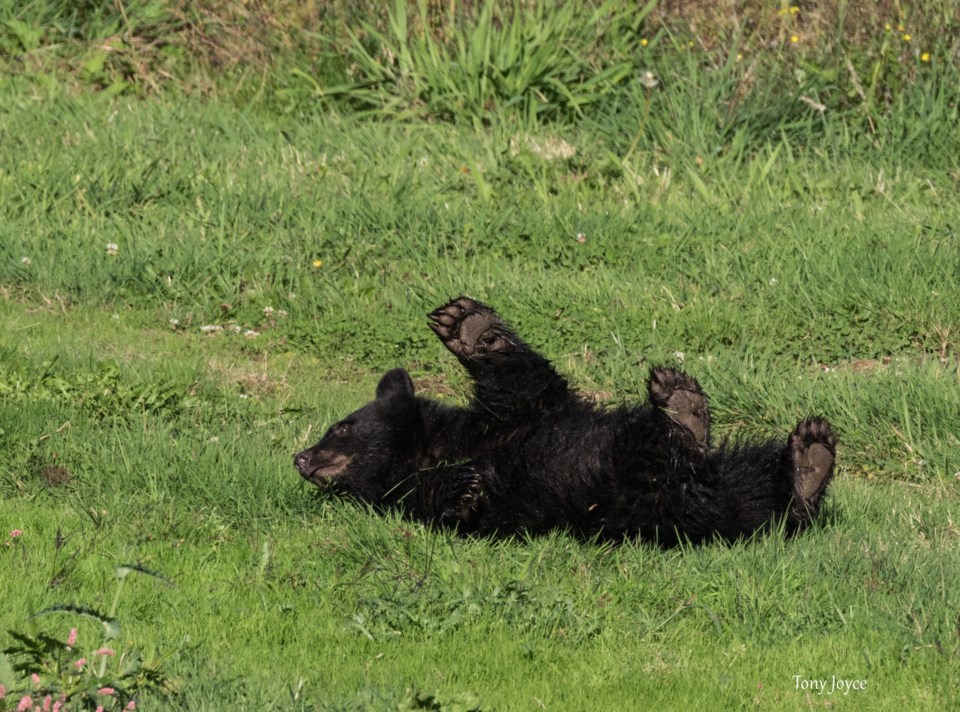Late spring and summer are busy times for local black bears. Curious cubs are exploring their new home, yearling bears are learning to navigate life independently of mom, berries are finally on the menu and males will soon be in pursuit of females as mating season approaches.
Expect to see cubs trailing behind mom or hiding in the tree canopy as she searches for food and safety close by. Play is a priority for these little adventurers, but with only 16 months with their mother, it is also a critical time to learn vital survival skills.
BEAR MOMS AND TEACHERS
Mothers have the responsibility of teaching their young how to climb, swim and cross roads. They show cubs where is safe, where to find food and how to navigate life in a world full of other bears, people, dogs, and wildlife. It is critical we do not interrupt this valuable time of teaching and learning. Please do not harass bears for photographs or allow dogs to be off-leash in areas where bears live.
Approaching bears can pressure them to feel defensive. Bears may be comfortable with people at a distance, but the boundaries of personal space are unique to each individual. Bears may use their voice to ask for space (huffing, jaw popping, excessive exhaling). Occasionally, they may take a step in your direction to request that you back away. This is how bears communicate to us when we are too close.
THE COLOURS OF THE SPRING ARE VIBRANT RED AND ORANGE
One unmistakable sign of late spring is the vibrant red and orange hues of salmonberries.
Berries are an essential food source for black bears and many other wild animals. Salmonberries are especially important, as they are the first berries to appear. After bears eat berries, they disperse the seeds in their scat and assist in replenishing the forest.
We think it is fair to ask that you please pick berries from residential areas and leave the berries in the forest for the animals that depend on them for survival.
DO’s AND DON’TS WHILE BIKING IN WHISTLER
With Whistler Mountain Bike Park open for the season, bear in mind that biking is a high-speed, quiet, technical activity that increases your impact and chances of a close encounter.
Respect all bear-in-area notices and trail closures. Be aware of your surroundings and avoid wearing headphones.
Only ride authorized trails. Illegal trails are destroying wildlife habitat, taking away vital food sources and safe places for bears to live. Bears learn where to expect people. Creating illegal trails makes our behaviour more unpredictable and increases the chances of an encounter.
Use your voice! Use a loud, firm tone and call out often. Be louder and slower in low-visibility areas and when travelling by water. Bears will try to avoid you, if given the opportunity.
Travel in groups; avoid biking alone.
If you see a bear ahead in the distance, back away and take an alternate route.
Don’t try to move a bear away from natural food to use the trail. Take another route.
Never leave food unattended. Pack in, pack out!
Always carry bear spray and know when and how to use it.
Off-leash dogs are involved in more than half of all negative wildlife encounters. We advise leaving dogs at home when biking.
If you encounter a bear: stay calm, slowly dismount. Place your bike on the ground between you and the bear. Speak calmly to the bear as you prepare your bear spray and slowly back away. Show you are not a threat. Give the bear an exit.
Remember that bears rest, play, forage and raise their young in the forest. Please be a respectful visitor.
Luci Cadman is certified in bear safety and awareness, and is a certified bear-viewing guide with the Commercial Bear Viewing Association of British Columbia. She has been the education coordinator for the North Shore Black Bear Society for five years. While bears remain Luci’s first love, she expanded the Society’s educational outreach in 2018 to include coyotes, bobcats and cougars.




